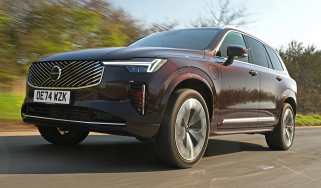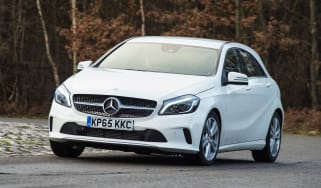Mercedes A-Class review – a comfort-focused premium hatchback
"Hi-tech, well built, stylish and as comfortable and luxurious as it should be: the Mercedes A-Class is a great premium hatchback"
Pros
- Great build quality
- Class-leading interior
- Impressive infotainment
Cons
- Underpowered entry-level petrol engine
- Not as sporty as some rivals
- Cramped rear seats
Verdict – is the Mercedes A-Class a good car?
The Mercedes A-Class is a great car for buyers after a premium experience with all the benefits of a practical hatchback. One of its biggest draws is its impressive build quality and interior technology, which cement it as one of the most desirable cars in its class. With the focus on comfort, it’s not quite as sporty as some rivals – the smallest entry-level engine feels rather underpowered, but the Mercedes A-Class is worth considering if you’re in the market for an upmarket small car, with the A 200 being the sweet spot for most buyers.
Mercedes A Class models, specs and alternatives
The Mercedes A-Class is a favourite in the premium hatchback class, representing a more affordable way into Mercedes ownership. While the original model from the 90s was a controversially-styled small MPV, the past two generations have adopted a more conventional hatchback shape and upmarket design, helping it appeal to a wider audience.
This is the fourth-generation Mercedes A-Class, and its silhouette doesn’t majorly differ from that of the last-generation car, but it now sports thinner, more aggressive headlights and tail-lights that give it a sleeker look. The A-Class starts from just under £31,000, which means it’s over £1,000 more expensive than the Audi A3 and slightly cheaper than the BMW 1 Series.
More reviews
More mainstream alternatives include the Volkswagen Golf, which costs about £3,000 less, but less obvious models include the Mazda3 hatchback, which actually looks and feels more premium than its bargain £24,010 starting price suggests, and feels very good to drive – it’s definitely worth checking this out, as it’s a car that feels like a halfway house between mainstream and premium hatchbacks and is well equipped and finished, especially in its highest trim, which still undercuts the A-Class and its other premium German rivals.
 The best luxury small cars to buy in 2025
The best luxury small cars to buy in 2025
Facelifted for 2023, the latest upgrades could be a final flourish for the A-Class, as Mercedes looks to move its model range further upmarket, with no direct replacement in sight. Its most recent changes include standard adaptive headlights and LED tail-lights, a smoother nose and an upgraded interior that also uses more recycled materials to boost its sustainability.
The A-Class' interior is miles ahead of most rivals. It's packed with sophisticated technology and boasts a modern design along with high-quality materials and great build quality, and the A-Class has led the family hatchback segment for some time now. The car's infotainment system is particularly impressive. Clever voice recognition tech together with a widescreen digital instrument and infotainment screen setup help amplify the hi-tech experience, with twin 10.25-inch displays made standard in 2023.
The A-Class seems to have set the template for modern interior design, with a number of cars such as the BMW 1 Series – and even the Vauxhall Astra – now featuring two similarly sized screens side-by-side.
There are now three core trim levels to choose from: Sport Edition, Sport Executive or AMG Line Executive. The base SE has now been withdrawn, while the Sport Edition trim is only offered with the A 180 petrol engine as an entry-level option. Buyers can also add 'Premium' or ‘Premium Plus’ packs to the AMG Line trim level, which adds extra equipment like automatic dual-zone climate control, a 10-speaker sound system and a panoramic sunroof.
The standard A-Class engine range comprises two petrol options, a diesel and a plug-in hybrid. The petrol engines offer between 134bhp and 161bhp and are badged A 180 and A 200 – there are two additional high-performance Mercedes-AMG ‘hot-hatch’ versions of the A-Class with bigger engines which we’ve reviewed separately – these are called the A35 with 302bhp and the A45 S with 415bhp.
A 2.0-litre diesel engine with 148bhp is available in the A 200 d but the previously-offered A 180 d and A 220 d have been discontinued. The plug-in hybrid A 250 e has also been carried over for the facelift, making it an attractive option for company car choosers in particular. Buyers after a fully electric car will be keen on the Mercedes EQA – essentially an electric version of the Mercedes GLA, which is based on the A-Class.
The A-Class is now available only with an automatic DCT gearbox, with a seven-speed unit for the standard petrol-engined variants, and an eight-speed for the diesel A 200 d.
With its 161bhp 1.3-litre petrol engine, the A 200 offers a good mix of performance and fuel economy, and we’d recommend it over the less-powerful A 180 model that feels a bit meagre in a car this upmarket. Unlike some of its sportier rivals, the A-Class has been developed with comfort as a priority – but how successful it is here can come down to which wheels are fitted, with big alloys transmitting more bumps into the cabin. The A-Class does feel at home on the motorway, though, cruising along as quietly and comfortably as you’d expect a Mercedes to. The steering is well weighted but doesn’t give much feedback and while there’s not much body roll, the car isn't as grippy as you’d hope.
The petrol A 180 and A 200 manage around 48mpg, which isn’t bad by any means, but the A 200 d diesel manages up to 57.7mpg. The latter will likely suit those tackling longer motorway miles.
The A 250 e plug-in hybrid is a good option for both private and business drivers. It was the first A-Class Plug-in Hybrid (PHEV), and shared the same turbocharged 1.3-litre petrol engine as the A 200 but linked to an electric motor and a 16kWh battery pack, increasing power to a considerable 215bhp. Claimed pure-electric driving range is up to 51 miles, up from 44 in the pre-facelifted model with a slightly smaller battery. As with any plug-in hybrid, this entirely depends on the type of driving you do and how often you recharge the battery.
On the practicality front, the A-Class is something of a mixed bag – it’s spacious and comfortable in the front, but less so in the rear, and offers a 350-litre boot that’s a little bit smaller than rivals. Split-folding seats allow the total load area to be expanded to almost 1,200 litres when needed.
If you value comfort and luxury over outright practicality and sportiness the latest Mercedes A-Class is a great choice. Its class-leading interior and technology make it a desirable prospect, while its hushed interior and smooth gearbox make it a joy to travel in. It’s just a shame the A 180’s petrol engine lacks punch; others offer a better balance of power and economy.
For a more detailed look at the Mercedes A-Class, read on for the rest of our in-depth review.
What about buying a used or nearly new Mercedes A-Class?
The latest Mercedes A-Class has quite variable residual values, from around 44 to 52 per cent of its new value after three years or 36,000 miles, which means some models are quite good value as a used car and others are less so. Go for a less desirable diesel model to get the most for your money; although some higher-powered petrol models such as the A250 are also a good used buy if you don’t mind the higher running costs.
What’s its history?
The first Mercedes A-Class launched in 1998 and it was something rather different from anything else on the market. Its upright styling and small footprint on the road meant it was more practical than it looked, and Mercedes spent so much on this innovative car that it actually lost the company money for each model sold.
In 2001 this version was updated, then it was replaced with an all-new generation in 2004, though this Mk2 model still had the upright design that set it apart from rivals from Audi and BMW.
In 2012 the much more conventional Mk3 A-Class arrived, and it was then updated in 2015 with some new equipment. In 2018 the current Mk4 version arrived.
Used Mercedes A-Class (Mk3 2012-2018)

The previous-generation A-Class still looks modern today, and although it’s more cramped and more uncomfortable than the current Mk4 car, it’s still a decent buy simply because prices are more affordable. It’s decent enough to drive, well equipped, the interior is pleasant and best of all, the engines are really efficient and cheap to run.
Read the full Mercedes A-Class Mk3 review...
Used Mercedes A-Class (Mk2 2004-2012)

The second-generation A-Class was practical for its small size, had really low running costs and it was easy to drive. Its interesting styling is another reason to consider one (it looks like little else that was available at the time) but it’s neither the most comfortable nor quiet car, especially on the motorway.
Read the full Mercedes A-Class Mk2 review...
Older Mercedes A-Class models
The first-generation Mercedes A-Class is worth considering as a used car if you love older cars that were innovative when they first came out. It was a revolutionary car for Mercedes and paved the way for more mainstream models in the brand’s range. It’s easy to drive and there are some versions that will do over 60mpg.








































